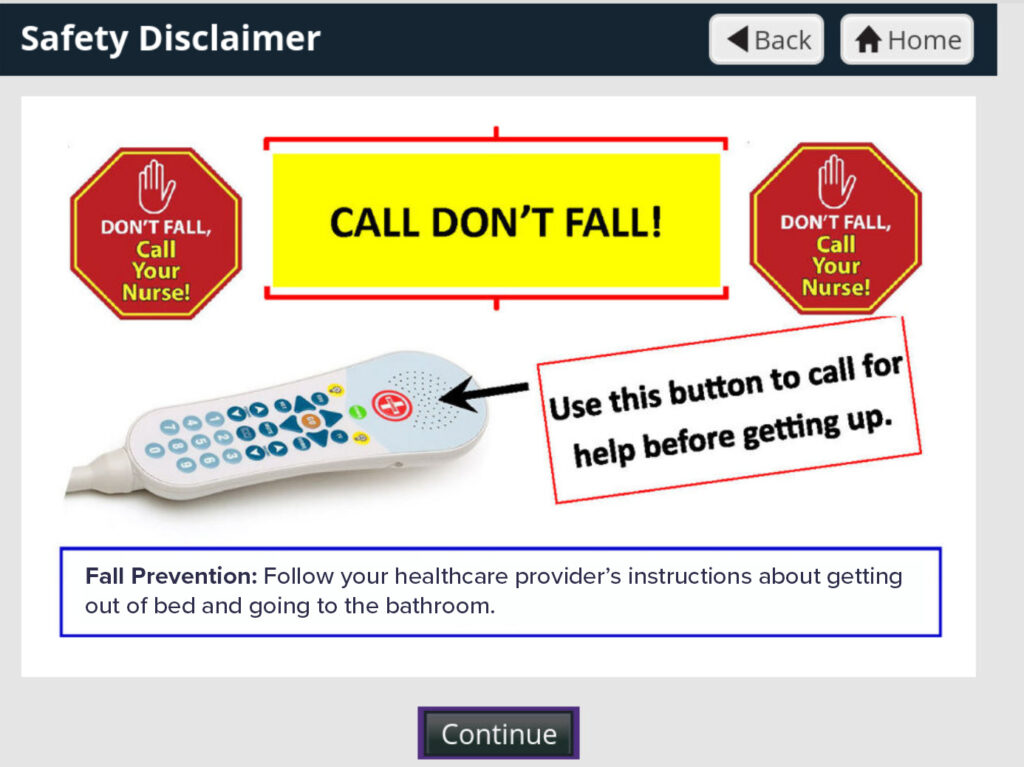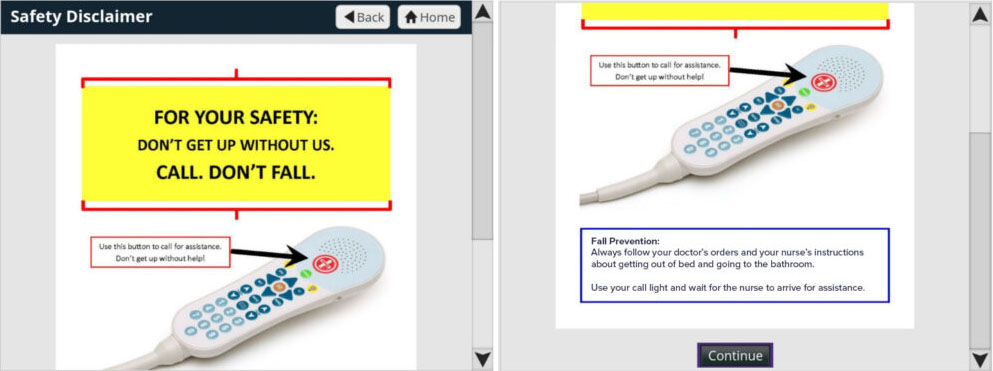Patient satisfaction, workflow efficiency, and quality and safety are three areas in which any healthcare organization should invest. A northwestern U.S. VA Healthcare system, has certainly done that, integrating people process and technology to meet safety requirements and reduce rates of hospital-acquired infections and improving outcomes for Veterans.
Earlier this month, a clinical nurse leader of this northwestern VA Healthcare system joined members of the Get Well team for our first Community of Practice webinar of the year. The Get Well team shared outcomes achieved by other VA facilities, reflected on outcomes in 2022, and shared updates on our journey to becoming FedRAMP-Authorized. The highlights of this 60-minute session are outlined below.
Expanded adherence to safety requirements
The northwestern system has partnered with Get Well since 2012 and currently uses Get Well’s digital engagement technology in the Medical/Surgical, ICU, CLC, and Dialysis units.
One area of focus for the organization was call light safety education, which aims to help prevent falls and injuries in the hospital setting. Prior to working with Get Well, it had no standardized system or documentation for staff or patients on call light education, which put patients at risk of not knowing which buttons to press in case of a call, and staff at risk of not knowing who internally had been properly educated on call light safety and patient orientation to the tool.
In evaluating a solution, a team of internal VA stakeholders and Get Well client success managers conducted a Root Cause Analysis, understanding the history, risks, and challenges associated with the issue, and then evaluated how and where they wanted proper call light safety education documentation and protocols put in place.
From that point, testing occurred in the VistA Computerized Patient Record System (CPRS), and the team went live with improved documentation procedures unit-wide. Now, a note is automatically documented into Vista CPRS indicating when proper training and orientation to call light safety has taken place. These before and after examples demonstrate how helpful the new education features are:


Since these improvements, the northwestern VA Healthcare System has seen an overall decrease in fall rates and are now meeting safety requirements.
Reduced rates of hospital-acquired infections
Next, the VA health care system’s team set their sights on reducing the rates of hospital-acquired C-Diff infections, (intestinal infections caused by certain strains bacteria), as there is a small window to “catch” incoming patients who come to the hospital with existing infections, and after 72 hours, infections are considered “hospital-acquired.” Since these infections are spreadable, the team sought to stop C-Diff in its tracks, at or near patient admission.
Catching these infections proved challenging, as Veterans are asked a number of intake questions in hospital triage, and can quickly become overwhelmed and forget details and existing infections can go unnoticed. Plus, asking additional screening questions at intake is time consuming for often overwhelmed clinicians.
Once again, the staff at this northwest VA Healthcare System and Get Well’s internal network of subject matter experts collaborated to determine:
- How to capture appropriate infection-related information
- Where, when, and how to launch a patient screening survey
- Appropriate reminders based on patient feedback
- And timely notifications for staff based on patient responses
In doing so, our teams created, tested, and optimized a survey appearing on in-room patient televisions via GetWell Inpatient, asking screening questions related to C-Diff. Based on survey logic and patient response, staff was notified of patients who may be a C-Diff risk. The clinical team marked the solution as a success for the way it gives clinicians time back in their day by launching automatically, providing patient reminders, and using tech to do screening on their behalf.
A year in review: looking back on 2022
The success at the northwest VA health care system is just one example of great work being done across the VA. Our Federal Community of Practice session also highlighted the key takeaways of a successful 2022 spent partnering with government systems around the nation.
In every partnership, Get Well helps our partners identify key areas where our solutions can create impact. These areas of focus include: patient satisfaction, workflow efficiency, and quality/safety. For each area, our team works with partners to identify an internal champion, or subject matter expert, who can help us understand the ins and outs of their systems, working to identify how we can drive efficiencies and maximize our value to partners.
“We’re not here to reinvent the wheel when it comes to performance improvement. We’re bringing in a technology piece to tech-enable your clinicians and staff so they can focus on top of license care.” — Karl Morneau, VP of Client Success, Government Division
In 2022, Get Well had five Veterans Integrated Service Network (VISN) wide contracts in place. In reviewing facility data and Survey of Healthcare Experience of Patients (SHEP) scores from 2022, we were proud to see that 92% of those facilities exceeded the national average for overall rating and willingness to recommend — a testament to our success in these partnerships.
A small highlight of accomplishments are:
- Patient satisfaction: 45% increase in satisfaction with staff responsiveness
- Workflow efficiency: 3% decrease in the Congestive Heart Failure readmission rate using our Heart Failure Care Plan
- Quality/Safety: 31% decrease in Hospital Acquired Infections (CLABSI)
Nationwide, our entire client community of 70 VA facilities completed more than 260,000
health education videos and more than 240,000 safety education videos. With each completion of these health and safety videos, our technology gives time back to clinicians to focus on care.
As a result of this work, our solutions realized 40,000+ hours of clinician time. This resulted in $1.5 million dollars saved on nursing staffing (assuming a national average or $40/hour).
What’s ahead?
Get Well will be FedRAMP Authorized in just a few months and is currently a FedRAMP “in process” system. Once FedRAMP Authorized, all of our cloud-based products will be available for launch within patient systems.
With FedRAMP Authorization, our GetWell Inpatient and GetWell Rounds+ Integration will include added functionalities, including web and QR-code based satisfaction surveys and other valuable patient-generated data, allowing staff to focus their care on the individuals who need it most. Government clients will also be able to use Rounds+ to conduct electronic mail and text based surveys.
GetWell Loop, which will be launched with authority to operate from FedRamp, puts our solutions in the cloud, offering the enhanced security the government is looking for and allowing us to integrate with existing systems for better patient connectivity. It allows our systems to connect with Veterans once they leave inpatient facilities and even connect with those who have never been in an in-patient setting but require care.
After a listening tour around the VA, Get Well learned that many Veterans visit care offices are outside of the VA network. As part of GetWell Loop, Get Well is launching a Repatriation Loop to bring community care Veterans back to the VA, drawing these patients back into the care we know is in every veteran’s best interest.
The team at Get Well is grateful for a successful 2022 partnering with VA systems around the country, and looks forward to offering expanded service lines, including FedRAMP authorization, in 2023. Thank you to the dedicated administrators who took the time to join our Federal Community of Practice session, and to the extraordinary healthcare workers using our tools on the frontlines every day. We look forward to continuing to serve you.
For more information on these solutions and more, schedule a demo with our team today.
The Federal Community of Practice is an ongoing webinar series connecting federal healthcare facility stakeholders with compelling case studies demonstrating Get Well’s commitment to information-sharing, performance improvement, and ongoing collaboration between our suite of patient engagement tools and healthcare centers nationwide.